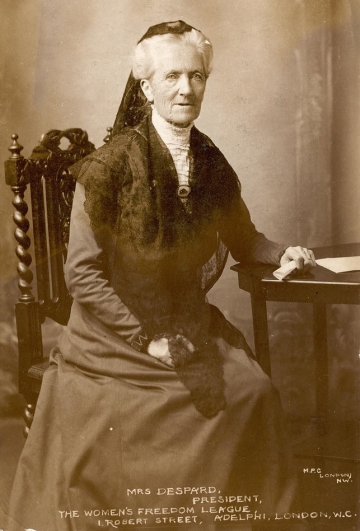Charlotte Despard
The full resource is FREE to all registered users of the website
If you are not already registered you can sign up for FREE website access to download the full resource.

- Born: 1844
- Died: 1939
- Occupation: Author
- Claim to fame: One of the founders of the Women’s Freedom League
Early years
Charlotte French was born in Kent into a comfortable but difficult background, as her father died when she was ten years of age and her mother was committed to an asylum.
Her husband, Maximillian Despard, encouraged her to write and she published a number of novels. Following his death in 1890, Charlotte moved to London to carry out charitable works. Shocked by the poverty that she saw, she set up community centres, a health clinic, youth and working men’s clubs and a soup kitchen. Like many of
the campaigners, she believed that women’s enfranchisement would enable women to do more to help their families out of poverty.
Suffrage activism
Charlotte joined the Union of Practical Suffragists and then the WSPU, but she didn’t like the political leadership and led a breakaway group named the Women’s Freedom League (WFL). The WFL had members up and down the country and its colours were green, white and gold. It also had its own newspaper, The Vote.
Charlotte and the WFL were prepared to break the law and to be arrested in order to win votes for women, but with restrictions. They would take part in protests and carry out politically targeted vandalism but not violence or arson; instead, they preferred civil disobedience.
Tax resistance was one method of disobedience that Charlotte favoured, and she was also one of the originators (with Laurence Housman) of the suffrage census boycott of 1911, refusing to fill in her own census form at her home at 2 Currie Street, Battersea, London. Her passive resistance activities led to her being imprisoned twice in Holloway Prison.
Throughout her lifetime Charlotte was a pacifist, and the First World War made no difference. She took part in anti-war rallies as well as sitting on the committee of the Women’s Peace Crusade set up in 1917. Her public anti-war stance was a direct contrast to her brother Sir John French, who was in charge of the British Army in 1914.
In 1918, after the partial enfranchisement of women, the WFL continued to fight until all women got the vote on the same terms as men. The WFL survived as an influential feminist lobbying group until 1961.
Glossary
- Holloway Prison: This was a Women’s Prison in London. It was where many of the suffragists and suffragettes were imprisoned if they broke the law.
- Partial enfranchisement: This refers to the fact that the 1918 Act only granted the vote to some women who met specific criteria.
Questions
- Why do you think that campaigners believed that women being allowed to vote would help to end poverty?
- How does civil disobedience differ from the activities of the more militant suffragettes?
- What impact do you think it had for women like Charlotte to be locked in prison?
